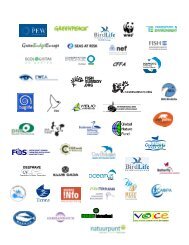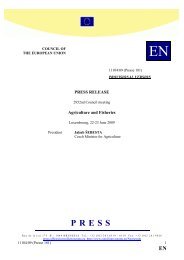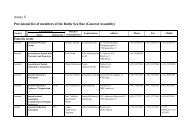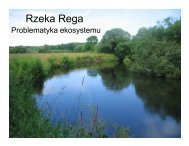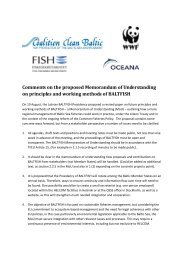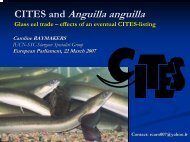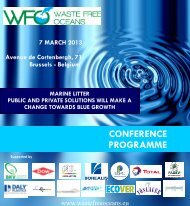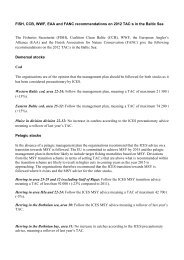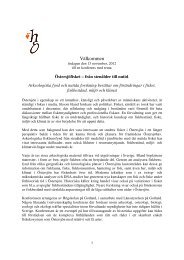A report on iUU fishing of Baltic Sea cod - Fisheries Secretariat
A report on iUU fishing of Baltic Sea cod - Fisheries Secretariat
A report on iUU fishing of Baltic Sea cod - Fisheries Secretariat
You also want an ePaper? Increase the reach of your titles
YUMPU automatically turns print PDFs into web optimized ePapers that Google loves.
DENMARKThe <strong>Baltic</strong> is the third most important <strong>fishing</strong>area for Danish fishermen – after the North <strong>Sea</strong>and Skagerrak, respectively (Anders<strong>on</strong>, 2002).The overall c<strong>on</strong>tributi<strong>on</strong> <strong>of</strong> the fisheries sector tothe ec<strong>on</strong>omy is small – about 0.5% – but it has avery str<strong>on</strong>g importance to specific regi<strong>on</strong>s whichare heavily dependent <strong>on</strong> fisheries for their livelihoods:north and west Jutland, and the island <strong>of</strong>Bornholm, where 95% <strong>of</strong> all landings by Danishvessels are made (European Commissi<strong>on</strong>, 2001).Approximately 5,650 fishermen work <strong>on</strong> 3,831vessels operating from Danish ports. The registeredt<strong>on</strong>nage <strong>of</strong> the fleet is 99,720 gross t<strong>on</strong>nage(GT). The table below provides a breakdown <strong>of</strong>the categories and number <strong>of</strong> vessels within theDanish fleet.species al<strong>on</strong>g with Norway pout, blue whitingand sprat, whereas, sprat are targeted in the Skagerrak/Kattegatand <strong>Baltic</strong> <strong>Sea</strong>. Owing to highlevels <strong>of</strong> dioxins which make them unsuitablefor human c<strong>on</strong>sumpti<strong>on</strong>, herring has also beenallowed to be targeted in some instances in the<strong>Baltic</strong> (RSPB, 2004).(ii) The pelagic fishery for human c<strong>on</strong>sumpti<strong>on</strong>,mainly herring and mackerel stored in tanks andlanded whole; and,(iii) The demersal fishery for white fish (<strong>cod</strong>,hake, haddock, whiting, saithe), flatfish (sole,plaice, flounder), lobster and deep water prawns(FAO, 2004).The table below indicates the total annual catch<strong>of</strong> fish from the <strong>Baltic</strong> <strong>Sea</strong> by Danish vessels.Category <strong>of</strong> registered vesselNumberSide trawlers56Stern trawler8Other trawler7Purse seine & combinati<strong>on</strong> vessels98Danish seiners 78L<strong>on</strong>gliners and gillnetters ,138Traps, poundnets ,574Dredgers and other vessels6TOTAL 3,831Source: Danish Directorate <strong>of</strong> <strong>Fisheries</strong>, 2002Cod are targeted by trawl and gillnets, withlandings <strong>of</strong> plaice and flounder normally associatedwith the trawl fishery. Sprat and herring aretargeted by trawl and purse seiners.The trawler fleets are based in the main ports inJutland and Bornholm with a large fleet <strong>of</strong> smallgill netters located in all Danish ports (EuropeanCommissi<strong>on</strong>, 2001; Danish Directorate <strong>of</strong> <strong>Fisheries</strong>,2002; FAO, 2004). The numbers <strong>of</strong> gillnettershas declined in recent years owing to thestock age compositi<strong>on</strong> with vessels switching tol<strong>on</strong>glining or trawling. The main pelagic fisheriesare c<strong>on</strong>ducted by a small fleet <strong>of</strong> purse seinersand large trawlers (ICES, 2005).Broadly speaking there are three types <strong>of</strong> fisheryin Denmark:(i) The industrial fishery for fishmeal and fishoil. In the North <strong>Sea</strong>, sandeel is the main targetDanish catches from the <strong>Baltic</strong> <strong>Sea</strong> (includingThe Belt and The Sound)Main 1993 1994 1995 1996 1997 1998speciesCod 11,843 19,836 34,613 48,521 42,581 29,488Herring 42,986 45,199 37,763 34,340 30,877 38,820Sprat 29,949 69,673 76,716 123,549 153,765 111.003Main 1999 2000 2001 2002 2003 2004speciesCod 38,174 32,050 29,148 21,558 22,342 19,936Herring 37,973 49,727 46,297 18,407 5,300 n/aSprat 97,685 55,521 53,411 47,630 32,000 44,300Source: adapted from Danish Directorate <strong>of</strong> <strong>Fisheries</strong>, 2002; ICES2005; OECD, 2005The processing sectorBecause <strong>of</strong> the inability <strong>of</strong> the domestic fleet tomeet the nati<strong>on</strong>al demand <strong>of</strong> Danish processors,there is a great reliance <strong>on</strong> imports to sustain theindustry. Denmark also acts as a “hub” for fishtrade. Figures for 2000 indicate there were 738companies dealing with processing and trade infish products: 83 in smoking and drying, 47 incanning and filleting, 5 in fish meal and fish oil,310 in wholesale trade and 293 in retail trade(FAO, 2004).Employment in the fish processing sector between1996 and 2000 is shown in the table below.– 52 –



